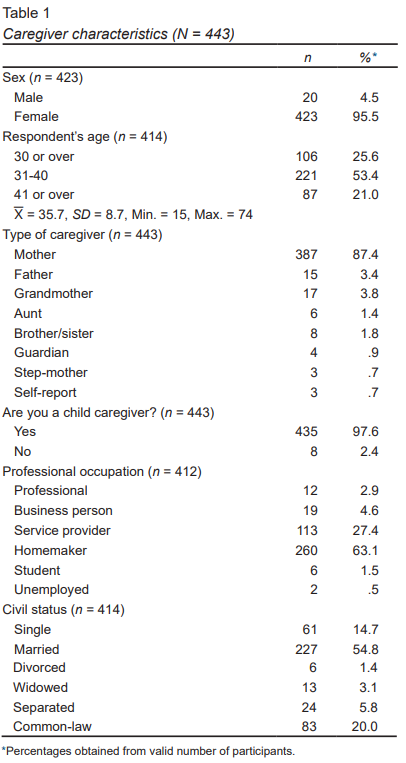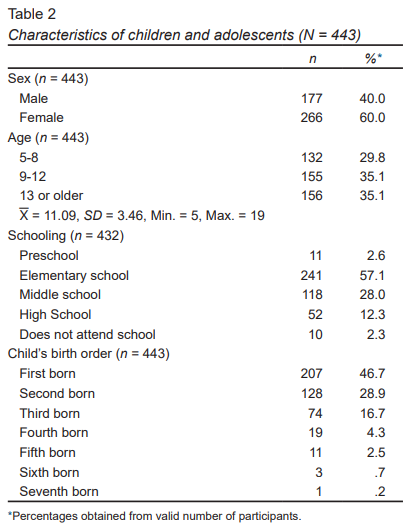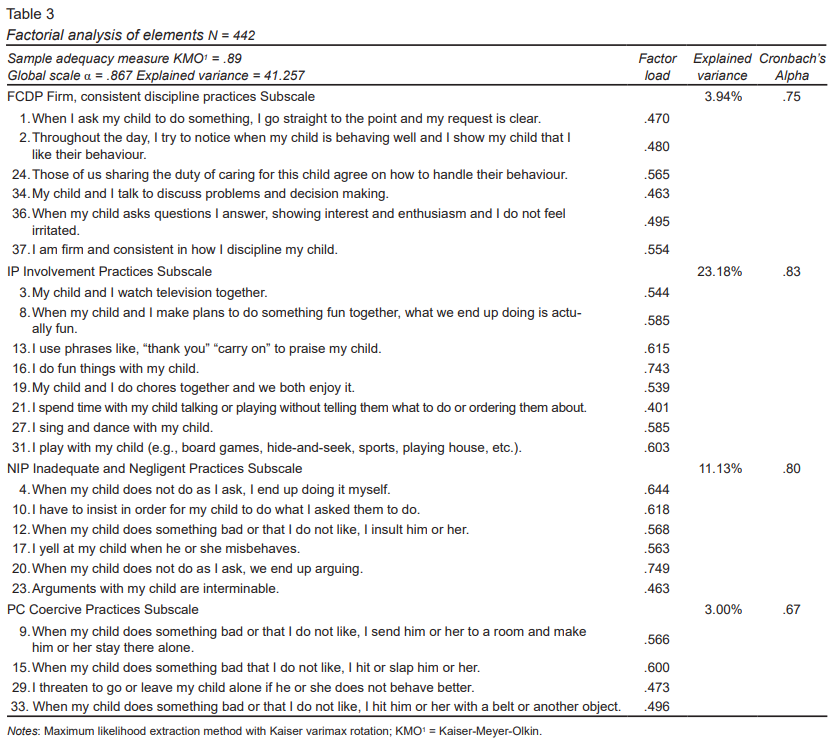Introduction
Parental practices (PP), refer to specific behaviours used by parents and caretakers of children to guide childhood development and socialization goals (Myers, 1993; Solís-Cámara & Díaz, 2007). These practices are associated with the children’s health, nutrition, and psychological and physical development, and their ability to learn everyday life skills that enable them to develop socially and create a safe environment (Darling & Steinberg, 1993; Forgatch & Patterson, 2010; Forgatch, Patterson, Degarmo, & Beldavs, 2009; Pichardo, Justicia, & Fernández, 2009; Repetti, Taylor, & Seeman, 2002).
Parenting practices have a direct impact on children’s behaviour (Solís-Cámara et al., 2007) as care patterns may act as risk factors when they foster behavioural issues or child psychopathology (Myers, 1993; Vera & Moon, 2013; Cuervo, 2010; Denham et al., 2000; Hill, 2002; Séguin & Pilon, 2013; Shaw, Gilliom, Ingoldsby, & Nagin, 2003), and may also be protective when they are positive, encouraging the development of skills and self-confidence in the child (Bauermeister, Cumba, Martínez, & Puente, 2008; Ramírez, 2007).
As part of the Epidemiological Surveillance of Children and Adolescents’ Mental Health Project (Caraveo, 2016), it was considered that PP should be evaluated. Thus, the Parental Practices Inventory (PPI), was chosen on the basis of what was both ideal and practical. The PPI is a 37-item self-report questionnaire for parents developed in Puerto Rico using items from the Parent Practices Scales (Strayhorn & Weidman, 1988) and the Parenting Scale (Arnold, O’Leary, Wolff, & Acker, 1993), as well as additional items based on the clinical experience of the authors. It was basically created to evaluate positive and negative practices across four areas: parental surveillance, supervision, participation, and discipline used (Bauermeister et al., 2008; Salas, 2001).
The aim of this study is to determine the psychometric characteristics, reliability, and confirmatory construct validity of the PPI for identifying the parenting methods used by caregivers of children and adolescents who attend healthcare facilities in Mexico City.
Method
Study design and participants
In a cross-sectional design, a secondary analysis was conducted in a sample of 443 caregivers of children and adolescents (ages 5-19) (Table 1), who participated in a larger study of patients who attended the general healthcare facilities of the Health Centre in order to establish the basic requirements for children’s mental health surveillance (Caraveo et al., 2011).
Procedure
Individual face-to-face interviews were conducted with the adults responsible for the child’s everyday care and lived with them on a daily basis. Interviewers were previously trained psychologists with experience working in the community.
Instruments
The original 37-item PPI was used, answered on a Likert type scale with four options: 0 = never or almost never, 1 = sometimes, 2 = frequently, and 3 = very frequently. Reliability reported by the authors showed an Cronbach’s alpha consistency of .85 and a bidimensional positive and negative parenting internal structure (Bauermeister et al., 2005). Negative parenting includes fourteen items referring to inconsistency (e.g., not agreeing), withdrawal of love (e.g., not saying that they love the child), and coercion-based behavioural control (e.g., punishment, insults, and yelling). A second positive parenting component includes 23 items referring to positive parenting practices, including approval strategies (praise), acceptance (commendation, encouragement), communication (reasoning, explaining), motivation (rewards, loss of privileges, etc.), synchronization (paying attention, being sensitive, and responsive to the child), and affection (physical and emotional contact).
The items regarding positive practices were recorded so that the entire scale had the same significance, higher scores indicating a greater presence of inadequate PPs.
Statistical analysis
Descriptive statistics were obtained for caregivers’ socio-demographic characteristics. After reviewing that data showed a normal distribution, the internal consistency for the whole test and subscales was estimated using the Cronbach’s alpha statistic. The PPI construct validity was analysed with exploratory and confirmatory analyses using the maximum likelihood estimation method (MLE). An exploratory factorial analysis of the main components and varimax rotation with a KMO normalization adjustment (Kerlinger, 1986; Kerlinger & Lee, 2002) was done. The criteria for including an item was that it should have a load higher than or equal to 0.40 and that it was not included in any other factor (Lloret et al., 2014). The SPSS for Windows (version 21) statistics package was used (IBM, 2012).
The information obtained from the exploratory analysis was subjected to a factorial confirmatory process with structural equation modelling in Bentler and Wu’s Structural Equations Programme (Bentler & Wu, 2005). This methodology is used to correct possible errors due to no-normal data distribution. The following goodness-of-fit indicators were used: 1. chi-square divided by degrees of freedom (quotients < 2 indicated good fit), 2. the Bentler comparative adjustment index (robust comparative fit index), and 3. the root mean square error of approximation (RMSEA). A good fit was acknowledged if the RFCI was equal to or greater than .95 and the RMSEA value was ≤ .05.
Lastly, a comparative analysis (Student’s t-test) of parenting practices using the characteristics of the children and their caregivers was performed.
Ethical considerations
The study was previously approved by the Ethics Committee and the Research Commission of the Instituto Nacional de Psiquiatría. The PPI was applied with the participants’ informed consent, and anonymity, confidentiality, and data protection measures were guaranteed.
Results
The caregivers’ average age was 35.7 years (SD = 8.7), with a range from 15 to 74 years. Time spent providing care for children was between 0 and 24 hours (X̄ = 5.20, s = 3.67). The largest proportion of respondents were mothers (87.4%), of whom 74.8% reported having a partner, while the rest were single, widowed, separated, or divorced. A total of 63.1% of the women were homemakers, followed by service providers (27.4%), and the remainder (9.5%) were engaged in other occupations or unemployed (Table 1).
The primary characteristics of the children referred by the caregivers in the study were: 60% female; 70.2% were nine years old or older (X̄ = 11.09, s = 3.46); most attended elementary school (57.1%); and 46.1% were the first born child in the family (Table 2).
Construct validity and internal consistency for the Parental Practices Inventory (PPI). The item concerning privileges was removed because it failed to discriminate (t [231] = -.709, p = .479). The original exploratory factor analysis for the scale included 36 items resulting in nine components that explained 43.7% of the total variance with α = .882. However, since five of the nine components comprised two items, a second analysis was done using a criterion of four components, based on Salas’ (2001) analysis of the revised PPI, with a 41.25% explained variance. Only twenty-four items were validated in this analysis (α = .867), since items related to the following were excluded: threats, rewards, storytelling, underestimating, explaining, co-management of behaviour, shared experiences, manipulation, withholding privileges, anger, lack of self-control, and the child’s lack of self-control. Each of the four subscales were labelled by the type of questions: 1. involvement practices (IP, α = .83); 2. firm, consistent discipline practices (FCDP, α = .75); 3. negligent, inadequate practices (NIP, α = .80); and 4. coercive practices (CoP, α = .67) (Table 3).
Validity of Parenting Practices Inventory (PPI) through confirmatory factorial analysis. A confirmatory factor analysis was conducted with the results obtained from the exploratory factor analysis of the four areas under consideration. Using the Lagrange multipliers, a good fit for the model was obtained (Figure 1), based on the correlation between the errors pertaining to the same factor. The statistics found were X2SB = 356.5130 (df = 235, p = .000), RMSEA = .034 with CI90%RMSEA = .027 - .041, RCFI = .950. Since the value of X2 for the four-component model was significant (p = .000), and since we had a large sample, we calculated the adjustment indicator through X2/df = 1.52.
Parenting practices and sociodemographic variables. The means presented for each subscale were: IP (X̄ = 11.68, SD = 4.85), FCDP (X̄ = 8.39, SD = 4.03), NIP (X̄ = 4.51, SD = 3.58), and CoP (X̄ = 1.35, SD = 1.69).
The results by caregiver occupation show that homemakers use more NIP (X̄ = 4.82, SD = 3.56) than other occupations (X̄ = 4.10, SD = 3.62) t (410) = 1.97, p = .049. Similar results were observed for CoP among homemakers (X̄ = 1.49, SD = 1.80) in comparison with other occupations (X̄ = 1.15, SD = 1.51) t (360.72) = 2.078, p = .038).
A comparison of the parenting practices used by caregivers according to the child’s age groups: 5 to 8 years, 9 to 12 years, and 13 years or over showed significant differences in the use of CoPs (F [2] = 8.43, p < .001). Using the Bonferroni post hoc test, a higher rate of CoPs in children aged 5 to 8 years old (X̄ = 1.72, SD = 1.87) and a low rate in the elder group (X̄ = .94, SD = 1.42) were identified. Also, differences were observed for the IP (F [2] = 3.166, p = .043), with a lower average for children aged 5 to 8 years old (X̄ = 10.81, SD = 4.95), when compared to the other two group (X̄ = 12.20, SD = 4.71; 9 to 12: X̄ = 11.90, SD = 4.84).
Discussion and Conclusion
The aim of the study was completely accomplished. Research instruments as evaluation tools for various issues require an estimation of their internal consistency and construct validity for the specific population being studied, since having valid, reliable instruments for the research groups may contribute to the progress of scientific knowledge in different areas. Roncero (2015) demonstrated that there is a need to further study various issues and to validate the use of research tools in populations sharing the same language. In this respect, research on parenting practices becomes more relevant and meaningful in the area of public health, because of their repercussions on children’s physical and psychological health.
The PPI instrument showed an appropriate internal consistency index (α = .867), similar (α = .850) to that reported by Bauermeister et al. (2005). This indicates that the instrument has sufficient consistency and stability to be applied to other populations.
Construct validity was adequate, since it evaluated what it was seeking to measure (Aguirre, 2014). Both the relevance and the representativeness of its content and its relation to the PPI criteria were confirmed. The 24 items comprised four subscales, which together explain 41.2% of the total variance. Confirmatory analysis showed the model’s good fit with the structure of four factors grouped into two central elements called positive and negative parenting, with a CFI = .950 being considered the most admissible (Messick, 1995; Jackson, Gillaspy, & Purc-Stephenson, 2009).
Due to the characteristics of the population of this study, items removed from the original version of the PPI were related to the affirmation of power and the use of force for behaviour regulation and control, storytelling, underestimating, explaining, co-management of behaviour, sharing experiences, lack of self-control, and the child’s lack of self-control. This aspect could be explained by the affirmation Covarrubias and Gómez (2012) made regarding the changes or resignifications of the Mexican families in their current practices (e.g., demanding with flexibility and authority, physical punishment without reaching levels of physical or verbal abuse, providing affection, and intentionally avoiding the mistakes made in their families of origin).
The strengths observed during this study are evidence of the confirmatory construct validity of the PPI in a representative group of caregivers seeking care at a Mexico City health centre. Furthermore, it was coherent with the theoretical evidence and the organization of the PPI. Both reliability and structure were consistent with Salas’ (2001) adaptation of the PPI. This suggests that the instrument’s psychometric function is adequate and that it provides relative confidence about the interpretation and scope of the results.
The results also showed that consistent, firm discipline practices are highly correlated with involvement practices, whereas negligent, inadequate practices are associated with coercive practices, thus resembling results from other authors (Aguirre, 2014; Cabrera, González, & Guevara, 2012; Vite Sierra & Pérez Vega, 2014), using different instruments and in other populations.
Interestingly, homemakers (who were predominant among the respondents) tended to use more coercive and negligent practices. Moreover, coercive practices were reported in higher numbers for younger children, as well as a lower number of involvement practices. As involvement practices explained most of the variance, the results suggest that preventive efforts should be directed on this topic (Soriano, García, & Caraveo, 2016).
There are limitations related to the nature of the study undertaken. The results only represent the type of population interviewed and cannot be extrapolated to the general population. There is therefore a need to continue to research the topic, using larger participant samples and providing more evidence on the way the inventory functions. However, this design showed adequate functioning. Likewise, future research should determine the possible link between the parenting practices of the primary caregiver and the presence of mental symptomatology in children and adolescents.
Results derived from the consistency and validity analyses provided substantial psychometric evidence to support the usefulness of the PPI in its current, 24-item version as a potential tool for researching parenting practices used by the caregivers of children and adolescents aged 5 to 19 in Mexico City. It made it possible to find differences in the type of practices used, either by the children’s age groups or the type of caregiver, as has been found in other reports of the literature.
Lastly, findings of this study have major implications for the development of programmes in a variety of contexts, where parenting practices are important for children’s physical and psychological health. They also reflect a resignification of parenting practices in Mexico, which points to the need to reevaluate the relationship between parenting beliefs and practices.



